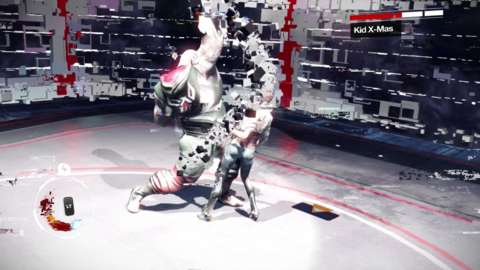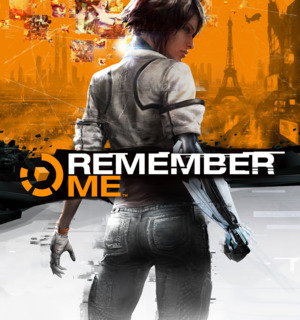"Give me a memory to remix, and I will change the world." As suggests its title, memory is the leitmotif in Remember Me's story and which all is about, at once problem and solution, altering also the language used in the game: Mnemopolis, Mnesist, Remembrane, amongst other clever neologisms. Stolen or wiped memories, memory-inhaling, memory remix, memory upload, memory-trading... Apparently, the developers (Jean-Maxime Moris) had an Orwellian future of social networks such as Facebook or Twitter in mind in which people could share their memories on the net thanks to the Sensation Engine (Sensen), a brain implant developed by Megacorporation Memorize which furthermore allows removing unwanted memory entries, starting with those of its creator and CEO, Charles and Scylla Cartier-Wells, themselves. And those of their repressed daughter, Nilin, Memory Hunter at service of the Errorists, a rebel underground group mobilizing against the negative effects of the corporate Memory sweetener: its overuse as both memory pooling and cleansing device as well as drug whose addicts become mindless Leapers languishing in Neo-Paris's slums and sewers.
Based in 2084, ten years into “Leaperization,” Remember Me strongly reminds of Blade Runner in both its cyberpunk setting and paranoiac atmosphere, but alas, the story soon degenerates into a soapy family drama in which Nilin lastly succeeds to manipulate her genitors' memories so that they eagerly recognize their past parental failure as well as that of their post-traumatic system: Bland New World. Videogame-wise it is Mirror's Edge with respect to modern urban style and female lead, and Syndicate as to futuristic setting and corporative story that perhaps come closest to Remember Me's eclectic mixture.

Memorizable above all is the well-designed correlation of visual, audio, and mnemic glitches with distortion as the main design principle behind Remember Me's dystopia, co-efficiently twisting images, music, and memories. As to the soundtrack, its remix of the original orchestral score by electronic means (Olivier Derivière) is probably what has least detrimental side-effects on the gameplay and in fact, suits the story extraordinarily well as it reflects Nilin's disarray in Neo-Paris's paramnesic chaos. Yet as the image begins to glitch once Nilin's not auto-recovered health reaches a critical level, optical distortion does not necessarily have positive effects and may not only result in occasionally quite ugly screens, but also impact combat itself, in particular when pixelated Leapers camouflage with the graphically dissolved scenery.
Visually, in the main, the combat mechanics is very efficient, though, closing up on Nilin's slowed down martial arts-inspired special or final moves, while her kicks and punches feel more convincingly “physical” than the somewhat gravity-lacking platforming sections. Combos are both easy to execute and to interrupt: the four available combo chains of different length (3-5-6-8-module) are formed out of various square (Punch) and triangle (Kick) button combinations whose order cannot be changed, but which don't need to be complete, either. For instance, four different 3-hit combos might be preferable to longer chains for being easier to perform, whereas 6, 7, and 8-hit ones are rewarded additional PMP (Procedural Mastering Power). Like sort of a combat DNA, reportedly 50,000 different combinations are possible out of these four basic strings, thanks to the four “Pressen” types consecutively unlocked during the first chapters: Regen/Heal (orange), Power/Damage (red), Cooldown/S-Pressens (purple), Chain/Multiplier (blue), for both the square and the triangle button. The combo system is complemented through the five special moves, the “S-Pressens” unlocked in accordance with the story episodes' combat tech needs, permitting to fall into high-speed frenzy (Sensen Fury), to stun a group of—susceptible—foes (Sensen DOS), to mount an armor-breaking EMP bomb (Logic Bomb), to hack a hostile robot to attack and self-destruct (Sensen RIP), or to memory-overload nearly attack-immune enemies (Sensen Camo). Moreover, thanks to some omni-tool, Nilin can also use “projectile” weapons like the Spammer and the Junk Bolt, useful to shoot weak Leapers off walls or to destroy Heavy Enforcer shields, which permit also to open door locks or later, pick-socket the energy from orange door mechanisms.
However ambitious, for the first half of the game at least just pressing one and the same button for combat should be sufficient, as more as longer chains often get either interrupted or are not well recognized (e.g., a punch after three kick moves does start a new chain instead of continuing the eight one started) so that adding graphic glitches and random enemy lock-ons, it is at times like having the gameplay options against oneself rather. Later on, in particular when fighting Elite Enforcers or Mourners, recurring to button combinations permitting to regain health or to shorten the 120s+ cooldown for the S-Pressens becomes more vital, though.
After escaping La Bastille prison, Nilin easily becomes Neo-Paris's public enemy no.1: the ubiquitous human Enforcer forces at service of the authoritative governor “Madame” and Memorize itself appear still relatively harmless considering that they inconsistently address Nilin with “little lady,” compared to the skinny zombie-like Leapers yowling words of “meat” and “face” while apparently craving for the but more immaterial memory. It would be inaccurate to consider them two separate groups of enemies, though, since the Reconversion Project ("humane responses to barbaric perils") thought up by Memorize's CEO and its crazed scientist Doctor Quaid, makes Leapers serve the S.A.B.R.E force as sort of disposable private army for the Corp. It is Scylla Cartier-Wells herself, however, who is “reconverted” and softened thanks to the Memory remix by Nilin, whereas Doctor Quaid ("Individualism is obsolete") is getting killed by his former assistant, Johnny Greenteeth, now a shadowy Leaper Mourner victim of some early memoriel accident.
One should point out that Nilin does not necessarily act on her own but throughout Remember Me's nine episodes is guided by a mysterious voice in her inner ear—or her Sensen—pertaining to Edge, the leader of the Errorists, in reality the residual memory of H3O (“M3morize Hominis EvolutiO”) the central memoriel server itself and all at once Nilin's helper, origin of the Leapers, and their reaper. Edge leads Nilin through the different parts of Neo-Paris: La Bastille fortress, Slum 404, Saint-Michel Comfortress, Memorize HQ, Mnemopolis tower, giving plenty occasion to admire the masterly blend of old with new Parisian architecture. As the story begins with Nilin having almost all her memory wiped (“so empty, so true”), she gains awareness of her skills above all thanks to Edge who makes her putting them to appropriate purpose: ape-like climbing over Neo-Paris's roofs and façades, she steals some memories—notably the secret codes of star architect Kaori Sheridan and that of Madame—and remixes others (Olga, Forlan, Scylla, Charles) in order to make Edge's secret plan work. Rewinding remembered scenes like a film reel while activating some of its potential memory bugs—an untied anaesthetic mask, a knocked-over bottle, a broken windshield, a short-circuited pet bear robot—is surely one of Remember Me's most remarkable ideas both narratively and by design. Other original gameplay elements are the “Remembranes,” permitting to project a hologram of a person's recorded actuation—Bad Request, Greenteeth, Sgt Vaughan, Dr Quaid, Cpt Trace—in order to override door controls, close a shutter, deactivate a minefield, and get access to the Conception Cube, which are to be added to the occasional environment puzzle consisting mainly of kinetically moving platforms or avoiding lethal surveillance drones.
Given Nilin's light-footed and combative fighting style and the combos combined out of damage, health, cooldown, and multiplier modules, most of the corridor and end-level fights are not very difficult to achieve, on the condition to collect the available 15 Focus boosts and 25 SAT patches on (and off) the way, adding one section to the partitioned Health / Focus bar every five each; well-placed "Pictures" provide useful clues here.
Other valuable collectibles are the 40 Mnesist Memories and the 55 cyber-entomic Scaramechs that permit gaining additional PMP to unlock new Pressen punch and kick types (53,000 to unlock all!). However, occasionally one encounters also some rather unwelcome functional “bugs” making it impossible to properly interact using the displayed circle button while Nilin remains inflexibly inclined in combat posture.
The Mnesist Memory entries on the other hand offer informative insight into the story's historical sci-fi background: as a milestone, the founding of Neo-Paris in 2053, also thanks to Memorize's founder (in 2012) Antoine Cartier-Wells's support, after the French metropolis got destroyed at the end of the European Civil War (2041-2047), started by some eco-terrorists in Berlin three years after “Deluge 2.0” as a result of global warming...
However, so interesting the background context, so clichéd and inconsistent the game's story itself: for instance, do we learn anything about how Nilin ended up Hunter, even Thief of memories, the fragile matter that made her parents' fortune, apart from Rudyard Kipling's (lengthy) loading screen quote: “If any question why we died, tell them, because our fathers' lied”? —The story ends as easy as visually disrupted with a boss fight against the personified H3O and some sketchy Latched Remembranes, and with Nilin having family and a damaged world to heal: "Our only truth is our sorrow" (Alphonse de Lamartine).
Much can be said about Remember Me's artistically inspired design, but its greatest asset, also with regard to the stunning Neo-Parisian cityscape with its clair-obscure lighting and wet pavement effects, becomes also its biggest detriment for pixelated enemies, glitching scenery, and sketched-out memory cubes don't always further the gameplay, in particular during the frequent fighting scenes.
So in total, while offering an interesting gaming experience combining exploration, platforming, and fighting elements embellished through a splendid setting, Remember Me falls short due to overly repetitive combat and simplistic story elements in spite of a strong female protagonist (voiced by Kezia Burrows).

